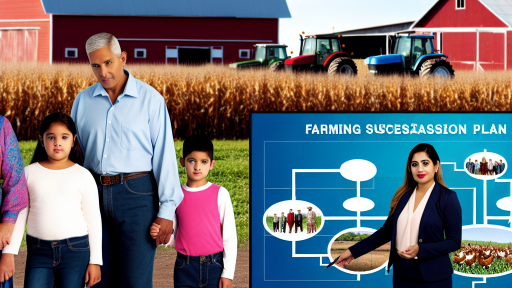Overview of Collaboration in Sustainable Farming
Importance of Collaboration
Collaboration enhances the efficiency of sustainable farming practices.
It allows farmers to share resources and knowledge.
Working together leads to improved agricultural techniques.
Moreover, it fosters innovation in farming methods.
Types of Collaborative Models
Several models exist for effective collaboration in farming.
Cooperatives are popular due to shared ownership.
These allow for bulk purchasing of supplies, reducing costs.
Partnerships between local farms can also improve productivity.
Joint ventures combine expertise from multiple sources.
This creates synergies and encourages diverse agricultural practices.
Successful Case Studies
Many regions have benefited from collaborative farming efforts.
The Farmer’s Alliance in Washington exemplifies teamwork.
They successfully increased crop yield through shared resources.
In contrast, the Organic Farming Network in California promotes knowledge exchange.
They demonstrate how collaboration can improve organic practices.
Transform Your Agribusiness
Unlock your farm's potential with expert advice tailored to your needs. Get actionable steps that drive real results.
Get StartedChallenges in Collaborative Efforts
Despite the benefits, challenges can hinder collaboration.
Communication gaps often lead to misunderstandings.
Additionally, differing goals may cause conflicts among members.
Time constraints can also limit participation in collaborative activities.
Overcoming these challenges requires patience and compromise.
Future Directions for Collaboration
The future of sustainable farming looks promising with collaboration.
Technology can enhance communication and resource sharing.
Online platforms allow for real-time cooperation between farmers.
Furthermore, integrating sustainable practices in education promotes awareness.
Ultimately, strong partnerships will help tackle global food challenges.
Key Principles of Effective Collaboration Models
Shared Vision and Goals
Effective collaboration begins with a shared vision.
All stakeholders must understand and align on collective goals.
This clarity fosters a more focused effort towards sustainable farming.
Open Communication
Open communication is vital for successful collaboration.
Teams need to share information freely and transparently.
Regular meetings can enhance understanding among participants.
Mutual Respect and Trust
Building mutual respect among collaborators strengthens relationships.
Trust encourages open dialogue and risk-taking.
Participants are more likely to share their ideas and concerns.
Defined Roles and Responsibilities
Clearly defined roles prevent confusion and overlap.
Each participant should understand their specific contributions.
This clarity enables smoother project execution and accountability.
Adaptability and Flexibility
Effective collaboration requires adaptability to changing circumstances.
Participants should be prepared to revise strategies as needed.
Showcase Your Farming Business
Publish your professional farming services profile on our blog for a one-time fee of $200 and reach a dedicated audience of farmers and agribusiness owners.
Publish Your ProfileFlexibility enhances problem-solving and innovation among teams.
Continuous Learning and Improvement
Collaboration should include a commitment to continuous learning.
Stakeholders need to assess and reflect on their processes regularly.
This approach promotes ongoing refinement of collaboration models.
Engaging Local Communities
Engaging local communities enriches collaboration efforts.
Community input fosters innovative solutions and practices.
It builds local support and enhances sustainability initiatives.
Incorporating Technology
Utilizing technology can enhance collaboration efficiency.
Digital tools facilitate better communication and data sharing.
Technology can also help monitor progress and outcomes.
Case Studies of Successful Collaborative Farming Initiatives
Community Supported Agriculture in Vermont
This initiative connects local farmers with consumers directly.
Consumers purchase shares of the harvest upfront.
This model supports farmers financially before the growing season.
Additionally, it fosters a sense of community among participants.
Members receive fresh produce throughout the season.
Overall, this approach enhances food security in the region.
Collective Farming in Kenya
Smallholder farmers in Kenya formed a cooperative model.
This allows them to pool resources for larger outputs.
The cooperative helps in purchasing seeds and fertilizers bulk.
They share knowledge and best practices among members.
Consequently, this initiative improves crop yields significantly.
Farmers gain a stronger bargaining position in the market.
Permaculture Networks in Australia
Permaculture cooperatives promote sustainable land management practices.
These networks share resources and expertise among members.
They hold workshops to educate about permaculture principles.
As a result, members implement innovative techniques on their farms.
This collaboration leads to healthier ecosystems and communities.
Agroecological Practices in Brazil
Farmers in Brazil have adopted agroecological principles collaboratively.
They focus on biodiversity to enhance agricultural production.
This model includes traditional practices passed down through generations.
Farmers share seeds and knowledge, enriching the community.
Furthermore, this approach improves resilience against climate change.
These sustainable methods have gained recognition globally.
Urban Farming Initiatives in Detroit
Detroit’s urban farming movement is a response to food deserts.
Community members transform vacant lots into productive gardens.
This initiative promotes local food production and access.
Volunteers work together to maintain these urban spaces.
Moreover, they educate residents on sustainable practices.
The movement strengthens local economies and improves health outcomes.
See Related Content: Optimizing Farm Operations Through Strategic Alliances
Showcase Your Farming Business
Publish your professional farming services profile on our blog for a one-time fee of $200 and reach a dedicated audience of farmers and agribusiness owners.
Publish Your ProfileRole of Technology in Enhancing Collaborative Farming
Introduction to Technology in Farming
Technology plays a crucial role in modern farming practices.
It introduces innovative solutions that improve efficiency.
Farmers increasingly rely on technology to enhance collaboration.
Communication Tools for Enhanced Coordination
Efficient communication is essential for successful collaborative farming.
Technological tools streamline communication between farmers.
Applications like WhatsApp and Zoom facilitate real-time discussions.
Moreover, farmers can share updates and concerns easily.
Data Sharing and Transparency
Technology allows farmers to share critical data transparently.
Platforms like Google Drive enable collaborative data storage.
Such tools foster trust among participating farmers.
They can collectively analyze data to make informed decisions.
Farm Management Software
Farm management software enhances operational efficiency.
Systems like FarmLogs help farmers track crop progress effectively.
These tools assist in resource management and distribution.
Moreover, they help optimize yields and reduce waste.
Precision Agriculture Technologies
Precision agriculture utilizes technology for resource optimization.
Farmers use GPS and sensors to monitor field conditions.
Such technologies enable informed decisions based on real-time data.
Additionally, they help reduce environmental impact significantly.
Collaborative Decision-Making Platforms
Collaborative platforms empower farmers to make group decisions.
Tools like AgriSync facilitate discussions on best practices.
Farmers can share insights and strategies effectively.
This approach leads to better farming outcomes and productivity.
Future Directions in Collaborative Farming
The future of collaborative farming appears promising with technology.
As technology evolves, farmers will benefit from new tools.
These advancements will strengthen their collaborative efforts.
Ultimately, sustainable farming practices will thrive.
See Related Content: Branding Techniques to Boost Your Farming Business
Benefits of Community-Based Approaches to Sustainable Agriculture
Enhanced Resource Sharing
Community-based models enhance resource sharing among farmers.
This approach reduces costs and promotes efficiency.
Moreover, it encourages collective purchasing of seeds and equipment.
This strategy minimizes waste and maximizes productivity.
Knowledge Exchange and Skill Development
Farmers benefit from knowledge exchange in community setups.
Workshops and training sessions foster skill development.
Experienced farmers can mentor newcomers, strengthening the network.
This sharing of expertise helps address local challenges effectively.
Improved Market Access
Community collaboration improves market access for farmers.
By banding together, they can reach larger markets.
Joint marketing strategies can enhance visibility and sales.
Additionally, community-supported agriculture programs increase customer loyalty.
Showcase Your Farming Business
Publish your professional farming services profile on our blog for a one-time fee of $200 and reach a dedicated audience of farmers and agribusiness owners.
Publish Your ProfileEnvironmental Stewardship
Community-based approaches promote sustainable farming practices.
Farmers are more likely to adopt eco-friendly methods collectively.
This mindset leads to enhanced soil health and biodiversity.
Consequently, communities can combat climate change more effectively.
Building Social Capital
Engaging in community-based agriculture builds social capital.
Farmers develop trust and stronger relationships through collaboration.
This unity fosters resilience against economic and environmental challenges.
Furthermore, it enhances community wellbeing and support networks.
Uncover the Details: Competitive Analysis for Agribusiness Success

Barriers to Effective Collaboration
Communication Issues
Miscommunication often impedes collaboration between farmers and stakeholders.
Different terminologies can create misunderstandings.
To address this, establish clear and common language standards.
Resource Limitations
Limited access to resources restricts collaborative efforts.
This includes financial, technological, and human resources.
Partnerships can help pool resources for shared projects.
Cultural Differences
Diverse cultural values may lead to conflict during collaborations.
Understanding and respecting these differences is essential.
Encourage open dialogue to bridge cultural gaps.
Resistance to Change
Farmers may resist new collaborative practices.
This resistance often stems from fear of the unknown.
Highlighting successful case studies can reduce this fear.
Strategies to Overcome Barriers
Enhancing Communication
Implement regular meetings to foster open discussions.
Utilize technology to streamline communication among all parties.
Feedback loops can ensure everyone’s voice is heard.
Building Resource Networks
Create alliances with local agricultural organizations.
These alliances can facilitate resource sharing.
Encourage participation in co-operative ventures.
Promoting Cultural Competence
Organize cultural sensitivity training for all stakeholders.
Encourage collaboration among diverse groups through shared activities.
Celebrate the unique contributions of each culture.
Fostering a Change-Friendly Environment
Promote a culture of innovation in farming practices.
Provide education on the benefits of collaboration.
Recognize and reward successful collaborative efforts.
See Related Content: Building Strong Export Partnerships in Agribusiness
Measuring the Impact of Collaborative Models on Sustainability
Defining Collaborative Models
Collaborative models involve partnerships among various stakeholders.
These stakeholders often include farmers, government agencies, and non-profits.
They seek to improve agricultural practices through shared resources.
Moreover, these models promote innovative solutions to common challenges.
Evaluating Environmental Outcomes
The environmental impact of collaborative models is crucial to assess.
Researchers often measure changes in soil quality and biodiversity.
Showcase Your Farming Business
Publish your professional farming services profile on our blog for a one-time fee of $200 and reach a dedicated audience of farmers and agribusiness owners.
Publish Your ProfileAdditionally, they analyze reductions in chemical use and emissions.
These metrics help evaluate overall ecosystem health over time.
Economic Benefits of Collaboration
Economic outcomes can significantly influence sustainability efforts.
Collaborative models can reduce operational costs for farmers.
For example, sharing equipment lowers individual financial burdens.
Furthermore, partnerships can enhance market access and bargaining power.
As a result, farmers often experience improved profit margins.
Social Impacts and Community Engagement
Social factors play an essential role in sustainable farming models.
Collaborations foster relationships among community members.
These partnerships can build trust and encourage collective action.
Moreover, shared initiatives often increase local knowledge and education.
Long-term Sustainability and Resilience
Measuring long-term sustainability requires ongoing evaluation.
Collaborative models should adapt to changing environmental conditions.
They must remain resilient against economic fluctuations as well.
Moreover, success relies on continued stakeholder engagement and commitment.
Future Directions for Sustainable Agriculture
Future studies should focus on refining measurement techniques.
Increased data collection will lead to better understanding of impacts.
Additionally, stakeholders need to develop tailored strategies for success.
Finally, collaboration remains key to achieving sustainable agricultural goals.
Future Trends in Collaborative Farming Practices
Integration of Technology
Technology plays a crucial role in modern farming.
Farmers increasingly use data analytics to enhance productivity.
Precision agriculture tools enable more effective resource management.
Moreover, drones assist in monitoring crop health and growth patterns.
Collaboration platforms connect farmers to technological innovations.
Community Engagement
Strong community ties are essential for sustainable agriculture.
Farmers engage in local initiatives to share knowledge and resources.
Cooperative models allow for pooling of resources and shared expertise.
Additionally, community-supported agriculture fosters local consumer connections.
Emphasis on Diversity
Diverse farming practices enhance ecosystem resilience.
Farmers are adopting polyculture systems to reduce vulnerability.
Furthermore, diverse crops improve soil health and biodiversity.
Collaborative efforts promote the exchange of diverse seeds and techniques.
Focus on Sustainable Practices
Environmental sustainability remains a top priority in agriculture.
Farmers prioritize regenerative techniques to restore ecosystems.
Furthermore, sustainable methods reduce reliance on chemical inputs.
Collaboration with environmental organizations strengthens these initiatives.
Market Access and Support
Collaborative farming enhances market access for smallholder farmers.
Farming cooperatives help in navigating complex supply chains.
Moreover, shared branding initiatives can increase consumer awareness.
Farmers can access more resources for marketing through collaboration.
Showcase Your Farming Business
Publish your professional farming services profile on our blog for a one-time fee of $200 and reach a dedicated audience of farmers and agribusiness owners.
Publish Your ProfileAdditional Resources
PepsiCo and Walmart Aim to Support Regenerative Agriculture …
Success of collaboration for sustainable agriculture: a case study …




